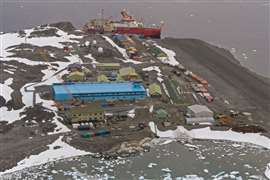Icebergs proposed for NYC's half-completed construction projects
23 June 2010

Architect Woods Bagot's New York City office is proposing covering some of the city's stalled construction projects with temporary "iceberg" structures.
With the global financial crisis bringing many of the city's construction projects to a halt, Woods Bagot said its "Iceberg" concept could provide community spaces, and advertising and rental revenues while also helping to keep neighbourhoods vibrant and attractive to potential investors.
The icebergs, which are made of "flexible and modular" units that can be bundled together to create different sized structures, are steel-framed buildings wrapped in a "plastic fabric" called EFTE (Ethylene tetrafluoroethylene ).
EFTE was used to clad the 2008 Beijing Olympics' Zaha Hadid-designed Water Cube and Munich, Germany's Herzog & de Meuron-designed Allianz Arena and weighs less than one-tenth that of a typical roof structure or glass curtain wall, but has high insulation qualities (see diagram).
The EFTE fabric has "air beams" stitched into it that act as structural supports. These are similar to those found on airplane evacuation ramps.
When inflated the EFTE becomes a "hard" structure that transforms the temporary building into a dramatic piece of contemporary architecture.
"The volume is almost nothing but air," said Woods Bagot's New York principal Jeff Holmes, "which means there's a minimal carbon footprint."
The buildings will also have a commercial value. Woods Bagot estimate that construction costs could be about US$ 2 million and that each "building" will have a rental value of approximately US$ 1 to US$ 2 million per year. The large panelled sides could also be used to display advertising "sensitive" to the area, according to Mr Holmes.
The structure can be dismantled in a week, from the plastic to the steel to the temporary concrete slab.
STAY CONNECTED


Receive the information you need when you need it through our world-leading magazines, newsletters and daily briefings.
CONNECT WITH THE TEAM










